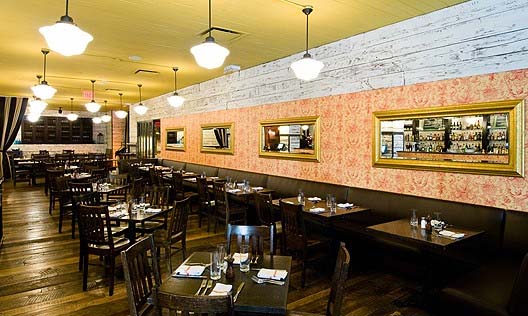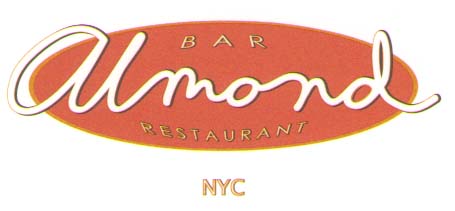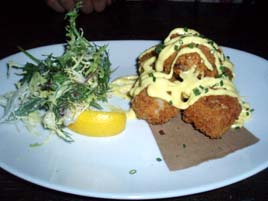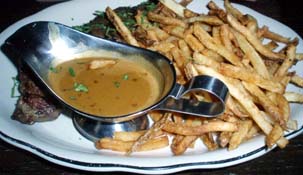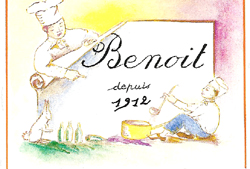
Note: Secession has closed. It will be replaced with a Japanese concept called Brushstroke, supposedly by the end of 2009 (but don’t hold your breath).
David Bouley has been a busy guy. He has something like seven restaurant projects going right now. We’re not talking about seven stable, business-as-usual restaurants, but seven in a state of flux. And we’re not talking about seven clones, but seven very different concepts. The obvious question is whether he can keep so many balls in the air, or if some of them—indeed, perhaps all—are going to land with an embarrassing thud.
So far, we have the answer for one of these: Secession, which just opened, replacing Danube. THUD. There is plenty of time to right the ship, but Secession needs a lot of work. With his next project, the new flagship Bouley, set to open next week, when will he have time to fix Secession, which right now is beyond mediocre?
It is not merely flawed execution—though there is plenty of that—but an absurd concept. The menu has practically as many options as a diner. It is more than any restaurant could expect to do well. And as one food board participant noted, they are almost sure to be always running out of things. If there’s to be any semblence of consistency, about half this menu needs to be jettisoned.
Perhaps they are heading in that direction. Last night, there were marginally fewer items offered than on the menu that I posted a couple of weeks ago. But it is still far too much, with something like 25 entrées and an equal number of appetizers in multiple categories. I mean, spaghetti carbonara and shrimp kebabs? They seem to be just phoned in. The menu, printed on a huge broadsheet, is also unwieldy to handle at the small tables.
The prices, at least, aren’t exorbitant. Almost all of the appetizers are below $15, and most of the entrées are $25 or less. Steaks range from $21 (skirt steak) to $32 (sirloin), but if they’re aged prime, as the menu says, that’s a pretty good deal. Nearly all of the wines are below $100, with many good choices below $50.
The brasserie menu and befuddled service are at war with the surroundings. Danube’s faux Klimt interior has been retained, which was a wise move, as this is still one of the most gorgeous rooms in town. It still feels like it should be a three-star restaurant, though it most certainly isn’t. Chairs and banquettes are comfortable, but our table wobbled. About halfway through, the server came by and stuck a piece of cardboard under one of the legs.


The charcuterie section of the menu offers nine homemade terrines, pâtés and boudins (sausages), all $11. We ordered two of those, and then waited. And waited. It made no sense, as these items are obviously pre-made. There was bread service, but it was stale. This was hard to figure, as the bread just next door, at Bouley, has always been excellent.
The boudin noir, or blood sausage (above left), comes with six different garnishes, but this isn’t clear on the menu, and our server was at a loss to explain it. Apparently they were out of one garnish, and had substituted another. Or something. For all that, it was pretty good. The Terrine du Chef (above right) had a flat, dull taste, and came out too cold, as if it had been in the fridge all day. The accompanying bread was again stale.



One of the more unusual menu items is Baby Goat; they were out of it, but didn’t bother to tell us this when the menus were handed out. I was offered Baby Lamb instead ($25; above left). It was presented in a cast-iron skillet, but I thought they’d serve it out onto a plate. Instead, they just left it for me to eat directly from the skillet, which was a bit wobbly. The kitchen did a respectable job with the lamb, but the potatoes underneath it were greasy and stuck to the pan.
I had asked the server to recommend a side dish. He suggested the mac ’n’ cheese, or technically “Grandmother’s Pasta and Cheesse Gratin” ($9; above center). Perhaps a better name is “supermarket pasta elbows.” They were too watery and not cheesy enough.
My girlfriend had the Skirt Steak ($21; above right). Apparently it was supposed to come with sauce, but the server forgot it; we did too, till we re-checked the menu afterwards. The steak itself was tender and nicely seasoned, but the accompanying schmear of what looked like mashed potatoes wasn’t any good at all. It also came with fries, which were soggy and limp. A runner asked what was wrong with them, and we told him. “I’ll tell the manager,” he said. Instead, our waiter came back and said, “Sorry about the fries.” At another table, the fries weren’t delivered till after everyone had finished their entrées.
Earlier in the evening, we’d had drinks at the bar, which they offered to transfer to our dinner tab. When the bill arrived, they weren’t on it. I’d like to think they were making up for the fries, but I doubt it. Surely, in that case, a manager would have come over and said something. I think they’re just discombobulated. We pointed out the apparent error. The server just said, “Forget about it.”
The dinner crowd was an eclectic mix. For the first part of the evening, the average age of the room was definitely over 50, but it got younger as time went on. The staff can’t decide what atmosphere they want in the dining room. Lighting levels were adjusted three times during the course of our meal. The full menu is also available at the bar. It has several comfortable tables, and a number of people seemed to be dining there by choice. It was standing-room-only by the time we left.
The dining room was never full, though it got close by the time we left, a bit after 8:00 p.m. Curiously, we were seated right next to a party of six, even though the restaurant was nearly empty when we arrived. About half-way through our meal, another party of two was seated right next to us, though there were a good dozen other two-tops with no one else around. Spreading people out when the dining room is empty is a pretty basic service concept, not yet mastered here.
There’s no reason Secession couldn’t be a great restaurant, but it isn’t right now. Too many basic things misfire. The staff is too confused. David Bouley needs to cut down the menu to about half of its currrent length, and the front-of-house needs a serious kick in the shins.
If there’s any silver lining, it’s that the prices are low, and that encourages a re-visit. If I hear that things have improved, I’ll drop by again one evening and dine at the bar.
Secession (30 Hudson Street at Duane Street, TriBeCa)
Food: Uneven
Service: Uneven
Ambiance: ***
Overall: Uneven (no stars)
 Sunday, March 29, 2009 at 01:51PM
Sunday, March 29, 2009 at 01:51PM 









